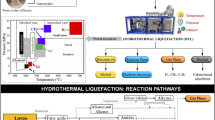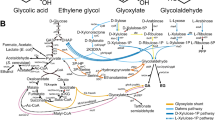Abstract
Clostridium acetobutylicum is a bacterial species that ferments sugar to a mixture of organic solvents (acetone, butanol and ethanol). This protocol delineates a methodology to combine solventogenic clostridial fermentation and chemical catalysis via extractive fermentation for the production of biofuel blendstocks. Extractive fermentation of C. acetobutylicum is operated in fed-batch mode with a concentrated feed solution (500 grams per liter glucose and 50 grams per liter yeast extract) for 60 h, producing in excess of 40 g of solvents (acetone, butanol and ethanol) between the completely immiscible extractant and aqueous phases of the bioreactor. After distillation of the extractant phase, the acetone, butanol and ethanol mixture is upgraded to long-chain ketones over a palladium-hydrotalcite (Pd-HT) catalyst. This reaction is generally carried out in batch with a high-pressure Q-tube for 20 h at 250 °C. Following this protocol enables the production of ∼0.5 g of high-value biofuel precursors from a 1.7-g portion of fermentation solvents.







Similar content being viewed by others
References
Durre, P. New insights and novel developments in clostridial acetone/butanol/isopropanol fermentation. Appl. Microbiol. Biotechnol. 49, 639–648 (1998).
Durre, P. Fermentative butanol production bulk chemical and biofuel. Ann. N Y Acad. Sci. 1125, 353–362 (2008).
Jones, D.T. & Woods, D.R. Acetone-butanol fermentation revisited. Microbiol. Rev. 50, 484–524 (1986).
Green, E.M. Fermentative production of butanol-the industrial perspective. Curr. Opin. Biotechnol. 22, 337–343 (2011).
Huber, G.W., Cortright, R.D. & Dumesic, J.A. Renewable alkanes by aqueous-phase reforming of biomass-derived oxygenates. Angew. Chem. Int. Ed. Engl. 43, 1549–1551 (2004).
Dellomonaco, C., Clomburg, J.M., Miller, E.N. & Gonzalez, R. Engineered reversal of the β-oxidation cycle for the synthesis of fuels and chemicals. Nature 476, 355–360 (2011).
Atsumi, S., Hanai, T. & Liao, J.C. Non-fermentative pathways for synthesis of branched-chain higher alcohols as biofuels. Nature 451, 86–90 (2008).
Blanch, H.W. Bioprocessing for biofuels. Curr. Opin. Biotechnol. 23, 390–395 (2012).
Tracy, B.P., Jones, S.W., Fast, A.G., Indurthi, D.C. & Papoutsakis, E.T. Clostridia: the importance of their exceptional substrate and metabolite diversity for biofuel and biorefinery applications. Curr. Opin. Biotechnol. 23, 1–18 (2011).
Ni, Y. & Sun, Z. Recent progress on industrial fermentative production of acetone–butanol–ethanol by Clostridium acetobutylicum in China. Appl. Microbiol. Biotechnol. 83, 415–423 (2009).
Jang, Y.-S . et al. Enhanced butanol production obtained by reinforcing the direct. mBio 3, 1–9 (2012).
Harris, L.M., Desai, R.P., Welker, N.E. & Papoutsakis, E.T. Characterization of recombinant strains of the Clostridium acetobutylicum butyrate kinase inactivation mutant: need for new phenomenological models for solventogenesis and butanol inhibition? Biotechnol. Bioeng. 67, 1–11 (2000).
Bormann, S. et al. Engineering Clostridium acetobutylicum for production of kerosene and diesel blendstock precursors. Metab. Eng. 25, 124–130 (2014).
Anbarasan, P. et al. Integration of chemical catalysis with extractive fermentation to produce fuels. Nature 491, 235–239 (2012).
Roffler, S.R., Blanch, H.W. & Wilke, C.R. In situ extractive fermentation of acetone and butanol. Biotechnol. Bioeng. 31, 135–143 (1988).
Sreekumar, S., Baer, Z.C., Gross, E. & Padmanaban, S. Chemocatalytic upgrading of tailored fermentation products toward biodiesel. ChemSusChem 7, 2445–2448 (2014).
Schwartz, T.J., Neill, B.J.O., Shanks, B.H. & Dumesic, J.A. Bridging the chemical and biological catalysis gap: challenges and outlooks for producing sustainable chemicals. ACS Catal. 4, 2060–2069 (2014).
Fisher, K. Neues Verfahren zur maßanalytischen Bestimmung des Wassergehaltes von Flüssigkeiten und festen Körpern. Angew. Chem. Int. Ed. Engl. 48, 394–396 (1935).
Acknowledgements
This work was funded by the Energy Biosciences Institute.
Author information
Authors and Affiliations
Contributions
S.S. and Z.C.B. contributed equally to this work. S.S., P.A., G.G. and A.G. performed experiments on the chemical catalysts, Z.C.B. optimized the fermentation and extractive processes. All authors contributed to the conception of the experiments, discussion of the results and preparation of the manuscript.
Corresponding authors
Ethics declarations
Competing interests
The authors declare no competing financial interests.
Rights and permissions
About this article
Cite this article
Sreekumar, S., Baer, Z., Pazhamalai, A. et al. Production of an acetone-butanol-ethanol mixture from Clostridium acetobutylicum and its conversion to high-value biofuels. Nat Protoc 10, 528–537 (2015). https://doi.org/10.1038/nprot.2015.029
Published:
Issue Date:
DOI: https://doi.org/10.1038/nprot.2015.029
- Springer Nature Limited
This article is cited by
-
Exploitation of novel wild type solventogenic strains for butanol production
Biotechnology for Biofuels (2018)
-
Complete lignocellulose conversion with integrated catalyst recycling yielding valuable aromatics and fuels
Nature Catalysis (2018)
-
Optimization of cellulase production by Penicillium sp.
3 Biotech (2016)





